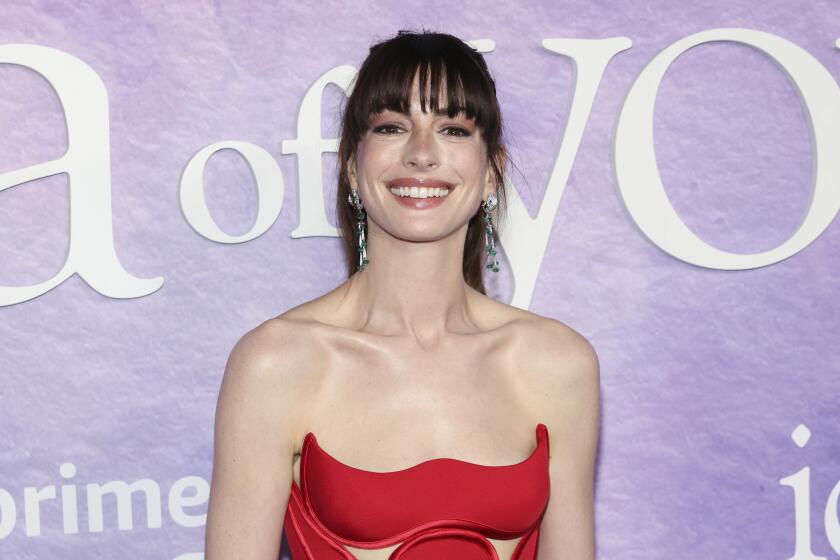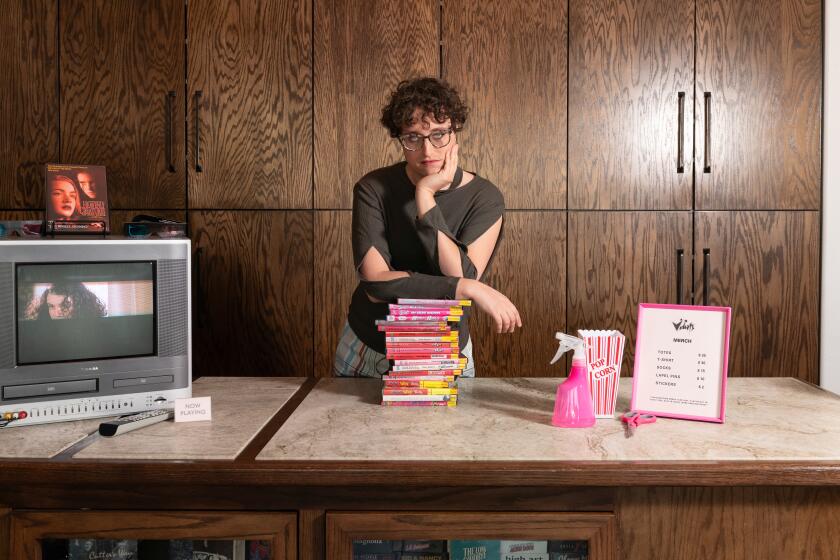In ‘Kate Plays Christine,’ an indie stalwart tells us something about acting -- maybe
What’s the hardest challenge you can face as an actor? Starring in a fact-based movie is certainly up there. Amid all the usual burdens are the voices -- real-life subjects, truth-squadders, internal demons -- bellowing at you to get it right.
But what if, when you signed on to make a fact-based movie, you also agreed to have your pre-shoot research filmed too, a “this is what someone did for the part and this is what that doing got them” sort of deal? And what if, to add to the complexity, those behind-the-scenes moments weren’t actually spontaneous but semi-scripted?
See more of Entertainment’s top stories on Facebook >>
Oh, and one more thing. What if the movie you’re preparing for isn’t real? I mean, some scenes from it will be shot but they won’t exist as a film per se, qua cinema.
Such is the head-spinning, meta-narrative exercise undertaken by veteran indie actress Kate Lyn Sheil (“House of Cards,” the movies of Alex Ross Perry) in her latest work. Sheil stars in “Kate Plays Christine” about a real-life Sarasota, Fla., TV reporter named Christine Chubbuck who killed herself on-air in 1974.
Directed by the experimental formalist Robert Greene -- and categorized, provocatively, as a documentary -- the film has Sheil tackling the challenge of inhabiting the part of Chubbuck.
Or rather, it has her tackling the challenge of inhabiting the part of someone preparing to inhabit the part of Chubbuck -- Kate plays Kate plays Christine.
“My interest in Christine Chubbuck on screen, my curiosity, that’s totally real,” Sheil said in an interview. “But I am acting the entire time. What I’m saying [as Kate] is true. But I’m also giving the answers Robert wants to hear.”
A moment later, she added, “It’s a very multi-layered and complicated piece to unpack.”
If there’s something vague and allusive and fraught with interpretation about how Sheil describes her role, that’s OK -- there’s something vague and allusive and fraught with interpretation about the movie in which it’s featured.
“Kate Plays Christine,” which premiered at the recent Sundance Film Festival and will likely be released later this year after more festival stops, is one of the more intriguing on-screen acting explorations to come along in some time -- in part because it’s an exploration of the work done by actors when they’re not acting. (Maybe.) It is the kind of movie that, absent a lightning-strike, probably won’t be widely seen in theaters. But its influence on how we perceive the craft of filmmaking -- on documentary, on performance -- could be immense.
The film begins with Sheil as (seemingly) herself, agreeing to take on the part of Chubbuck in a supposed scripted movie. The actress is known for her understated roles, and she can be seen telling a loved one how she is tired of being called “subtle” by reviewers. Here we have a real-life actress, performing emotionally in telling us how she is not allowed to perform emotionally, a supposed unguarded moment in which she can’t but be aware of the camera.
(Part of the slippery fun of “Kate Plays Christine” is wondering how much of the honest glimpses we’re catching are really that. Documentary, after all, is performance, as Greene makes clear in interviews. Sheil in the interview described the feelings she expressed in the film as “true on that day.”)
Soon the actress is off to South Florida, engaging in preparations to play the part of Chubbuck, via work both cosmetic (tanning beds and hair salons) and consequential. She calls those who knew the journalist or have worked at the station where Chubbuck did. We see her patiently listening to several of the late journalist’s former co-workers, sharing what Chubbuck was like, showing Sheil rare footage. Oddly, though this is not the alleged point of the film, we are learning information about Chubbuck, whose death even decades later remains clouded in mystery. It’s a historical documentary by-the-by.
Sheil proceeds to absorb what she’s learned, and the film eventually takes us into scenes from the movie-within-a-movie, which are frequently cheesy. This transition is instructive -- the gap between the naturalist rhythms of the documentary and the stilted staging of the feature highlight the difficulty of an accurate on-screen rendering.
“Those reenactments were intended to be bad, because part of what we were trying to get across in the move is our inability to tell Christine Chubbuck’s story,” Sheil says.
Yes, they are making a movie whose point is to comment on the futility of itself.
(But wait. The whole point of even the documentary footage is to show how that form can be distortive and misleading too, you say? Down that road lies madness.)
In any event, the effect is layered, and often inverted. Sheil and Greene (the real ones) are working very hard behind the scenes so the scripted movie they supposedly want to be good is really bad, and striving with equal gusto to ensure the documentary that they want to seem real reads at least partly as fictional.
That all this centers on Chubbuck is no accident. Though her story is little known outside media and entertainment circles (where she is recognized as the partial inspiration for “Network”), the anchorwoman symbolized a time when the person on screen was not the story. Chubbuck’s bosses were pushing her for more sexy coverage, often involving violence, but she wanted to more civic-minded policy pieces -- substantive but dry type of stuff. Chubbuck was a bulwark against the superficial, image-conscious tidal wave that was to come in local TV news, and it’s no accident that Greene picked her as his vehicle to examine what’s real on a film or television screen.
(Incidentally, there was another Chubbuck movie at Sundance, a more conventional fact-based drama titled “Christine” in which Rebecca Hall stars as the reporter. The movie played in the same theater as “Kate Plays Christine.” Delving too hard into the implications of this may make your head pop off.)
In looking how an actor investigates her role, “Kate Plays Christine” investigates what it means to be a performer. But it’s a more timely question than that. In this TMZ age it asks how someone can subsume themselves in a role (or ask us to trust their subsuming) when we know so much about them off screen?
It helps in this regard that Sheil, 31, does not have a high profile. She can create a narrative of herself -- “actress tired of playing ‘subtle’ characters” -- without the viewer becoming distracted with where the line between celebrity information and reality lies. Most of us don’t know Sheil, so why not take her at her word? (This would not work for, say, Jennifer Lawrence.)
The actress, who has the same quietly thoughtful mien in person as in many of her roles, has also expanded into writing, including as one of two screenwriters in Zachary Treitz’s “Men Go to Battle,” a Civil War movie that premiered to some acclaim at the Tribeca Film Festival in the spring. Centered on two brothers at the dawn of the conflict, the movie managed to create the thrill of a large-scale period piece on a small budget -- in part by shooting, on the sly, at Civil War reenactments.
“When we started writing the movie years ago it maybe had a bit more of a stunt-y thing to it, people walking around modern-day Cincinnati as if it’s the Civil War,” Sheil said in an interview at Tribeca. “And over the course of writing the script, without us realizing what was happening, it became painfully sincere. And by the time we were shooting we were incredibly sincere.”
Sheil’s career has stayed sufficiently under the radar that she theoretically has the opportunity to move about without typecasting. But with its band of close-knit directors and word-travels-fast reputations, the indie world can offer its own version of pigeonholing, and much of Sheil’s work has come in the “subtle” vein her character describes semi-indignantly in “Kate Plays Christine.” (On “House of Cards,” she played the coolly churning Lisa Williams.) The chance to break out is welcomed.
At Sundance, she also appeared in Starz’s TV-series adaptation of Steven Soderbergh’s “The Girlfriend Experience.” Sheil plays Avery, the wild friend of Riley Keough’s more buttoned-down heroine -- another chance to expand, seized after one of the show’s executive producers, Amy Seimetz, cast her against type. “Kate Plays Christine” and “The Girlfriend Experience” are almost in dialogue with each other, the frustrations expressed in one finding resolution in the other.
And, of course, there was the chance to act, at least for some scenes, like the voluble and colorful Chubbuck in “Christine.” “I don’t get asked to do costumes or wigs or much extreme character work, so this felt like a welcome opportunity,” Sheil said.
The film eventually moves to the climax of Chubbuck’s story in which, during a moment of explosive drama, the line between the journalist’s torment and that of Kate herself are blurred in an incandescent haze.
Was Sheil deeply imprinted by the paces she went through researching the role? Or are her actions simply a comment on our own expectations for how research can affect an actor? The film doesn’t explain, and Sheil doesn’t entirely reveal. Like so much related to ‘Kate Plays Christine,” truth isn’t an absolute road. It just winds its way somewhere in the general vicinity of reality, letting the viewer divine the destination.
Twitter: @ZeitchikLAT
ALSO:
Is awards season having a Donald Trump moment?
In ‘Christine,’ Rebecca Hall brings balance to an imbalanced subject
For family and friends of James Foley, ‘Jim’ is a mark of the man
More to Read
Only good movies
Get the Indie Focus newsletter, Mark Olsen's weekly guide to the world of cinema.
You may occasionally receive promotional content from the Los Angeles Times.







